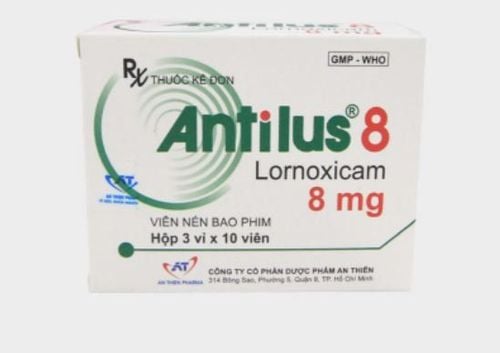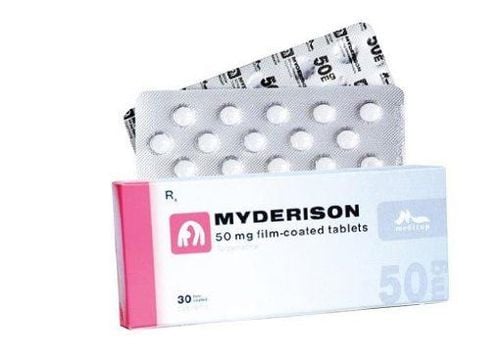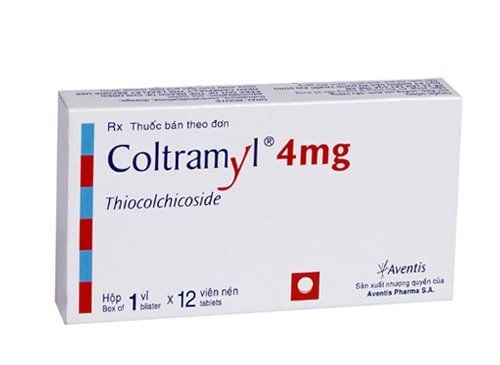This is an automatically translated article.
Mepheboston with the main compound is Mephenesin belonging to the group of muscle relaxants, increasing muscle tone. The main effect of Mepheboston is to relieve pain in patients with osteoarthritis. Knowing the information about indications, uses and dosages will improve treatment results and prevent side effects of drugs.
1. What is Mepheboston?
Mepheboston medicine is made in the form of film-coated tablets of 250 mg or 500 mg with the composition:
Mephenesin 250 mg, 500 mg. Excipients: Microcrystalline Cellulose, Hypromellose, Corn Starch, Magnesium stearate, Polyvinyl alcohol, Polyethylene glycol 6000, Silicon dioxide, Xanthan gum, Sunset yellow (E110), Talc, Titanium dioxide, Ponceau 4R (E124) in sufficient quantity . Mephenesin is a muscle relaxant with a pharmacological mechanism of action on the three levels of the central nervous system, the spinal cord and the peripheral nervous system. In addition, Mephenesin also acts directly on smooth and skeletal muscle fibers.
Mephenesin acts at the nerve reflex arc in the spinal cord, inhibiting the excessive activity of nerve reflexes, thereby relaxing the muscle.
Neuromuscular blockade mechanism causes muscle relaxation and mild sedation, acting on the whole body as well as having a local effect if formulated in the form of a cream. Mephenesin acts on skeletal muscle to reduce muscle excitability.
2. Uses of the drug Mepheboston
Mepheboston drug is indicated for the following cases:
Support to relieve pain caused by spasticity in degenerative spine diseases, spinal posture disorders, cervical scoliosis, low back pain, back pain. Support the treatment of muscle spasticity seen in multiple sclerosis or Parkinson's disease. Other muscle spasms with pain.
3. Contraindications to the use of Mepheboston
People with hypersensitivity to the ingredients of the drug. People with porphyria. Pregnant women or women who are breastfeeding.
4. Usage and dosage of Mepheboston
For adults and children > 15 years old:
Mepheboston dose (500mg): take 1-2 tablets/time, 3 times a day. Mepheboston dose (250mg): take 2-4 tablets/time, 3 times a day. Children < 15 years: There are currently no recommendations for the use of Mepheboston in children. Therefore, caution should be exercised when using this drug in this population.
To avoid unwanted side effects, it is necessary to carefully read the dosage and treatment instructions on the drug packaging. Do not arbitrarily change the dose and method of use without the consent of the treating doctor.
5. Notes when using Mepheboston:
Side effects when taking the drug
In patients who use the drug in excess or for a long time, it can cause unwanted effects such as tremors, abdominal cramps, nausea, sweating, even convulsions. .
The most common is fatigue, lethargy, drowsiness, muscle weakness, shortness of breath, ataxia. Less commonly, generalized arthralgia, nausea, vomiting, diarrhea or constipation, restlessness, rash. In some cases, there may be loss of appetite, hallucinations, agitation, even anaphylaxis. Symptoms that are mild, such as somnolence, rash, or allergic reactions, or as severe as anaphylaxis, are rare. Adverse effects may disappear after discontinuation of the drug. In case the symptoms do not decrease or worsen, it is necessary to notify the treating doctor or immediately go to the nearest medical facility for timely treatment.
Notes on drug use in subjects
Caution when using Mepheboston in the following cases: People with a history of bronchial asthma, a history of aspirin allergy or hypersensitivity reactions to the components of the drug. People with respiratory disease, impaired liver and kidney function, muscle weakness, history of drug addiction. Pregnancy or breast-feeding: There are currently no clear studies evaluating the potential for fetal malformations in patients receiving Mepheboston during pregnancy or lactation. Therefore, should be used with caution or not in these subjects. Before use, consult your doctor and pharmacist. Side effects such as drowsiness, muscle weakness, or decreased ability to coordinate movements often affect drivers or workers operating machinery... so the drug should be avoided while working.
6. Mepheboston drug interactions
Drug interactions with other drugs:
Do not use the combination of Mepheboston with Morphine in the treatment of elderly patients, because it may increase the respiratory depression effect of Morphine.
Drug interactions with drinks and food:
Use of alcohol, beer or other neuroleptic drugs may enhance Mepheboston's central nervous system effects. This increases the likelihood of drug-related side effects.
7. Preservation of Mepheboston
The drug is stored at room temperature below 30 degrees Celsius, away from moisture, sunlight and high temperature. The medicine should be kept out of reach of children.
Above is basic information on usage, dosage, indications, contraindications, unwanted effects and notes of Mepheboston. Read the instructions for use on the package carefully and follow the instructions given by your doctor or pharmacist to get the most effective treatment.
Please dial HOTLINE for more information or register for an appointment HERE. Download MyVinmec app to make appointments faster and to manage your bookings easily.













